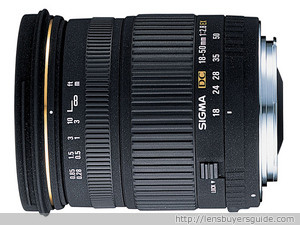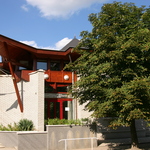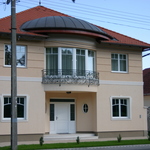Lens finder
Sigma 18-50mm f/2.8 EX DC
APS-C sized imageLenses that create APS-C sized image are designed for digital only. They cannot be used on cameras that have image sensor larger than the APS-C format. These lenses are not suitable for film cameras either. No Ultrasonic AFLenses with ultrasonic focusing mechanism tend to be quiter and faster than traditionally focusing lenses. No stepping motor AFLenses with stepping motor focusing mechanism are better for contrast based focusing, and are quiter and faster than traditionally focusing lenses. One or more Low Dispersion lens element is usedLow Dispersion lens elements help to reduce chromatic aberration. Not stabilizedImage stabilization helps to reduce blur caused by hand shake, especially at high focal length or in low light situations. Image stabilization can give 1 to 3 stop advantage over none stabilized lens, based on the reciprocal rule. Metal mountCheaper lenses are usually equipped with plastic mount, while more expensive, professional lenses have metal mount. In general, metal mounts are more durable, and a good thing to have when lenses are changed a lot. When a camera is used mainly with one lens, the material of the lens mount is not that important. Internal FocusingInternally focusing lenses don't change their size while setting focus. The front lens is fixedThe fixed front lens is not rotating during zoom and/or focusing. This allows the photographer to use petal shaped lens hood. Fixed front lenses also make the use of polarization filters a lot easier. No drop-in filter supportDrop-in filters are used in those lenses where either the front lens is too large, or the field of view doesn't permit the use of traditional filters at the front of the lens. Usually bright tele and ultra-wide angle lenses support this filter type. |
|
|
The characteristics of digital SLR cameras were taken into consideration when designing the lens power layout. A Special Low Dispersion (SLD) glass lens element provides effective compensation for lateral chromatic aberration, which is likely to occur with digital SLR cameras. The use of two aspherical lens elements provides correction for various aberrations and makes high quality images a reality throughout the entire zoom range. A Special Low Dispersion (SLD) lens and two aspherical lens elements provide excellent correction for all types of aberrations. Super Multi Layer (SML) coating gives the best color balance and reduces flare and ghosting from which digital cameras tend to suffer. This lens has a minimum focusing distance of 28cm throughout the entire zoom range which is very convenient for close-up photography. The lens is equipped with an inner focusing system. This lens has excellent correction for vignetting which is a common problem of large aperture lenses. Its new design ensures superior peripheral brightness.
|
Sigma 18-50mm f/2.8 EX DC Specification
| Available mount(s) | Canon EF, Nikon F, Pentax K, Sony / Minolta A, FourThirds, Sigma |
| Application(s) | Portrait, Landscape, Architecture |
| Category(s) | Standard zoom |
| Multiplier | 1.5× |
| Stabilizer | no |
| Focal length | 18 - 50 mm (2.8× zoom) |
| Lens construction | 15 elements in 13 groups |
| Angle of view |
35mm: N/A digital: 69.3-27.9° |
| Number of blades | 7 |
| Maximum aperture | wide: f/2.8 tele: f/2.8 |
| Minimum aperture | wide: f/22 tele: N/A |
| Minimum focusing distance | 28 cm |
| Magnification | 0.2× |
| Filter size | 67 mm |
| Size | ∅ 74.1 × 84.1 mm |
| Weight | 445 g |
| Notes |
|
| AF speed | N/A |
| AF sound | |
| Internal focusing | yes |
| Internal zoom | N/A |
| Fix front lens | yes |
| Mount type | metal |
| Weather sealed | N/A |
| Drop in filter | no |
| Ultrasonic AF | no |
| Stepping motor AF | no |
| APS-C sized circle | yes |
| Low dispersion lens element | yes |
| Hard case | N/A |
| Soft case | included |
| Lens hood |
included printable lens hood |
| Tripod adapter | N/A |
| Discontinued | yes |
Sigma 18-50mm f/2.8 EX DC Reviews
Other reviews
- Sigma 18-50mm f/2.8 EX DC review at www.ephotozine.com (English)
- Sigma 18-50mm f/2.8 EX DC review at www.the-digital-picture.com (English)
- Sigma 18-50mm f/2.8 EX DC review at www.shuttertalk.com (English)
- Sigma 18-50mm f/2.8 EX DC review at www.the-digital-picture.com (English)
- Sigma 18-50mm f/2.8 EX DC review at pixinfo.com (Hungarian)
Sigma 18-50mm f/2.8 EX DC in the news
- Tamron SP AF60mm f/2.0 Di-II Macro
- Nikkor AF-S DX 85mm f/3.5G ED Micro
- Carl Zeiss Distagon T* 35mm f/2.0 ZF
- Sony SAL2875 28-75mm f/2.8 SAM
- Carl Zeiss Distagon T* 28mm f/2 with EF mount
- Tamron SP AF17-50mm f/2.8 XR Di II VC LD Aspherical
- Carl Zeiss Distagon T* 2,8/21 for EF mount
- Carl Zeiss Distagon T* 3,5/18 ZE
- SIGMA 70-300mm F4-5.6 DG OS
- Nikkor AF-S 16-35mm f/4 G ED VR
















